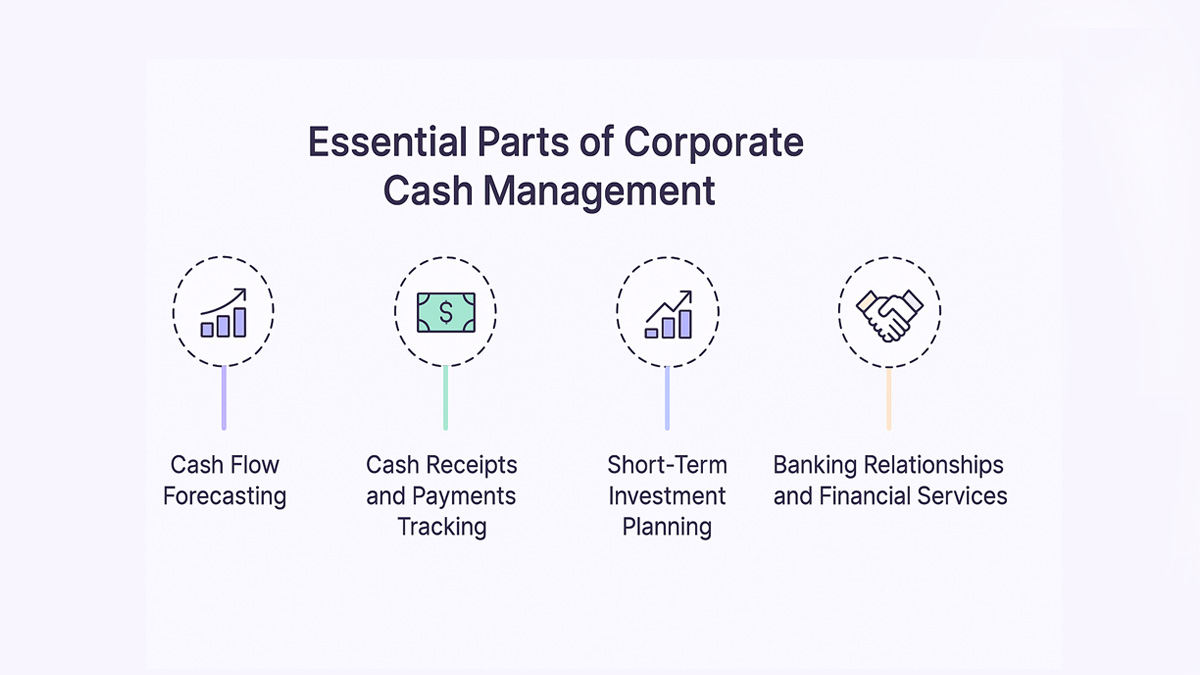

How Corporate Cash Management Helps Business Owners

How Corporate Cash Management Helps Business Owners
Learn how corporate cash management improves liquidity, reduces financial risk, and drives smarter business decisions.


Imagine running a business where money flows in from customers and flows out to suppliers, employees, and service providers - all while trying to grow, invest, and stay prepared for the unexpected. Without visibility or control, that flow can turn chaotic. Poor cash management is one of the top reasons businesses fail, especially in their early stages.
Corporate cash management is how businesses stay on top of their finances, maintain control, and unlock opportunities for growth. When done right, it’s not just about managing money - it’s about managing momentum.
What this blog covers:
- What is corporate cash management?
- Why corporate cash management matters for growing businesses
- Key components of an effective corporate cash management strategy
- How corporate cash management improves liquidity and control
- Choosing a corporate cash management solution for your business
- How Spendflo helps with corporate cash management
- Frequently asked questions on corporate cash management
What is Corporate Cash Management?
Corporate cash management is the process of monitoring, planning, and optimizing a business’s cash flow. It covers everything from incoming revenues to outgoing payments to ensure liquidity, reduce risk, and support financial goals. It includes tools and practices that help companies handle cash balances, investments, and transactions more efficiently.
Why Corporate Cash Management Matters for Growing Businesses
When a business starts scaling, its financial complexity scales with it. Suddenly, it’s not just about having money in the bank - it’s about knowing when it’ll arrive, where it needs to go, and how long it can sit idle before becoming a missed opportunity. That’s where corporate cash management steps in - as a stabilizing force for growing businesses navigating the unpredictable tides of financial operations. It also lays the groundwork for robust cash flow management across functions.
Here are the key reasons why cash management becomes mission-critical for scaling companies:
Improves Business Liquidity and Flexibility
Cash isn’t just king - it’s movement. Effective cash management ensures businesses have enough liquidity on hand to meet daily obligations without dipping into emergency reserves. When businesses know their exact cash position, they can react faster, make timely payments, or seize last-minute opportunities without disrupting ongoing operations.
Reduces Financial Uncertainty and Risks
Volatile markets, shifting customer payment patterns, and unexpected expenses can quickly derail growth plans. Structured cash management reduces that volatility by forecasting inflows and outflows, setting thresholds for cash reserves, and creating a safety net. These practices play a critical role in preserving a company’s financial stability, especially during volatile periods. It’s a form of proactive financial risk management that minimizes surprises - and keeps the lights on when the unexpected hits.
Enables Better Investment and Growth Decisions
Idle cash is a lost opportunity. By understanding cash cycles and accurately forecasting surpluses, companies can make low-risk, short-term investments that earn returns without locking up capital. This might include treasury instruments or other short-duration assets, which help multiply idle cash without compromising liquidity.
Supports Efficient Financial Operations
As businesses grow, so do their vendor relationships, customer bases, and internal processes. A strong cash management function supports smoother payment cycles, improves accounts receivable performance, and prevents late fees or missed discounts on payables. It also ensures accounts payable are prioritized based on timing and impact. In short, it reduces friction across financial transactions - and that means smoother operations, better relationships, and lower costs.
Cash management isn’t just a function for the finance team - it becomes a strategic lever that can influence profitability, resilience, and long-term sustainability.
Key Components of an Effective Corporate Cash Management Strategy
A strong cash management strategy doesn’t rely on instinct or spreadsheets alone - it’s built on systems, discipline, and clarity across the financial lifecycle. The goal? To ensure every dollar is accounted for, optimized, and aligned with the company’s broader financial objectives. Objectives
Here’s what makes up a solid cash management foundation:

Cash Flow Forecasting
You can’t manage what you can’t predict. Cash flow forecasting helps businesses anticipate incoming and outgoing funds across various time horizons - daily, weekly, monthly, or quarterly. It also aligns closely with the cash flow statement, offering a clear financial snapshot. It provides visibility into whether the company will have enough liquidity to meet obligations and reveals potential gaps before they become problems. Forecasts become especially valuable during periods of rapid growth, seasonal swings, or market uncertainty.
Cash Receipts and Payments Tracking
It’s not enough to know how much money is coming in and going out - you need to know when. Timely tracking of cash receipts (from customer payments, sales, or funding) and cash payments (like payroll, vendor invoices, or rent) ensures smooth operations and helps maintain a healthy operating cycle. Tracking every cash inflow and outflow accurately helps avoid bottlenecks. Tools like automated invoicing, payment reminders, and reconciliation systems can drastically improve timing accuracy. Many systems now also support remote deposits, reducing trips to the bank.
Short-Term Investment Planning
When excess cash is just sitting in an account, it's losing value to inflation. Businesses with disciplined cash management strategies often allocate idle cash into short-term, low-risk investments like money market funds or treasury bills. Choosing the right instruments depends on market trends and the prevailing interest rate. The key is to earn a return without compromising liquidity - investments should be accessible when needed, not locked away in long-term commitments.
Banking Relationships and Financial Services
Strong partnerships with financial institutions are crucial. This can even open access to a flexible line of credit when cash runs tight. The right bank can offer tailored treasury management services, real-time transaction tracking, competitive pricing on financial products, and dedicated support during cash crunches. Consolidating bank accounts can also streamline reconciliation and improve oversight. Building these relationships early can open doors to better financing, lower cost of financial services, and greater operational flexibility.
How Corporate Cash Management Improves Liquidity and Control
Liquidity isn’t just about having money - it’s about having accessible money, right when you need it. For a growing business, that distinction can mean the difference between capturing a golden opportunity and missing out. Corporate cash management gives organizations the tools to stay liquid and the control to act decisively.
Here’s how it strengthens both:
Maintains Optimal Cash Balances
Too much cash sitting idle? You’re missing out on growth. Too little? You’re risking a financial squeeze. Cash management strategies help maintain a “goldilocks” balance - not too high, not too low. This involves setting minimum reserve levels for operating costs while sweeping excess funds into short-term investments or high-yield accounts that offer better returns.
Ensures Real-Time Visibility Into Transactions
Modern cash management tools offer dashboards that display your financial position in real time - down to the last cent. These dashboards often track wire transfers and remote transactions automatically. This visibility empowers finance teams to track inflows and outflows as they happen, spot discrepancies quickly, and react to changes in the cash position without waiting for end-of-month reports.
Supports Risk Management and Diversification
With a clearer picture of cash flows, businesses can better assess financial exposures. For example, if one major client delays payment, how does that affect your ability to cover upcoming payroll or vendor costs? Cash management systems help flag such risks early. They also enable diversification of investments - spreading idle cash across multiple low-risk instruments to avoid overdependence on a single source.
Improves Decision-Making Capabilities
Cash management doesn’t just give you more control - it helps you make smarter decisions. Whether it’s negotiating vendor payment terms, deciding on a big software purchase, or evaluating insurance costs, knowing your liquidity position makes your financial choices more confident and calculated. You’re no longer guessing - you’re acting with clarity. That clarity extends to every projected cash outflow across the business. Liquidity and control aren’t luxuries in today’s economy - they’re lifelines. And businesses that master both will outpace those that don’t.
Choosing a Corporate Cash Management Solution for Your Business
Not all cash management tools are created equal - and the right solution for your business depends on more than just features and pricing. It comes down to how well the tool fits into your workflows, integrates with your financial systems, and scales alongside your goals.

Here’s what to consider before you decide:
Factors to Consider Before Choosing a Solution
Start by identifying the gaps in your current process. Are you struggling with forecasting accuracy? Do approvals take too long? Are you managing cash manually across multiple spreadsheets? These pain points should drive your choice. Look for solutions that improve visibility, reduce manual effort, and support better decision-making across departments.
Evaluating Tools and Technologies
Modern cash management platforms offer everything from real-time dashboards and automated payment scheduling to integrations with ERPs and accounting software. The best solutions offer features like automated bank reconciliations, cash position tracking, and scenario modeling - allowing finance leaders to play out “what if” situations and plan accordingly.
Also, look for intuitive user interfaces. If your team can’t navigate the platform easily, adoption will suffer. Features are great - usability is better.
Working With Financial Institutions and Advisors
Some businesses may benefit from partnering directly with their banks or treasury consultants to set up more advanced tools. Banks often offer specialized cash pooling, liquidity optimization, and interest-bearing sweep accounts. These fall under broader cash management services that support financial control. A hybrid approach - using both tech tools and professional guidance - can offer the best of both worlds, especially for businesses with complex needs or multiple entities.
Aligning Strategy With Business Size and Goals
A startup with 10 employees doesn’t need the same cash management tools as a global enterprise. Many small businesses benefit from simplified tools that still offer real-time visibility. Choose a solution that’s proportionate to your current size - but capable of scaling as you grow. If your goal is aggressive expansion, you’ll need a system that can handle multiple currencies, regional banking relationships, and deeper cash flow analytics.
In short, the best cash management solution isn’t the one with the longest feature list - it’s the one that empowers your team to move faster, act smarter, and manage money with confidence.
How Spendflo helps with corporate cash management
Spendflo empowers finance and procurement teams to take control of SaaS-related cash flows - one of the fastest-growing expense categories for modern businesses. By centralizing software spend, automating approvals, and tracking renewals in real-time, Spendflo helps businesses forecast cash needs more accurately, avoid unexpected charges, and reduce financial waste.
With Spendflo, you don’t just manage your spend - you optimize it. This means better visibility, fewer surprises, and smarter decisions that improve overall cash control and liquidity.
Frequently Asked Questions on Corporate Cash Management
What are the main benefits of corporate cash management?
Corporate cash management helps businesses maintain liquidity, reduce financial risks, and make informed decisions. It improves cash flow visibility, supports better vendor and customer relationships, and enables organizations to optimize surplus funds through short-term, low-risk investments - all contributing to healthier financial operations.
How does corporate cash management improve liquidity?
By forecasting cash flows and tracking real-time transactions, businesses can maintain just the right amount of cash on hand. This prevents over-reliance on credit or emergency reserves. Efficient cash management ensures that obligations are met on time while still preserving flexibility for investments or unexpected expenses.
What tools are used in corporate cash management?
Common tools include cash forecasting software, automated payment and receivables platforms, real-time dashboards, treasury management systems, and integrations with accounting or ERP software. Many businesses also work with banks for services like cash pooling or sweep accounts to manage balances more effectively.
How often should businesses review their cash management strategy?
Ideally, businesses should review their strategy quarterly - or more frequently during periods of high growth, market volatility, or cash flow strain. Regular reviews help ensure the strategy stays aligned with changing business needs, identifies potential inefficiencies, and adapts to external financial conditions.
What’s the role of banks in cash management?
Banks play a key role by offering tools like treasury services, automated payments, sweep accounts, and short-term investment options. They also help businesses manage foreign currency, reduce transaction costs, and access credit facilities. A strong banking relationship often means better service terms, faster resolution, and more tailored financial support.










.png)




.png)










.avif)





